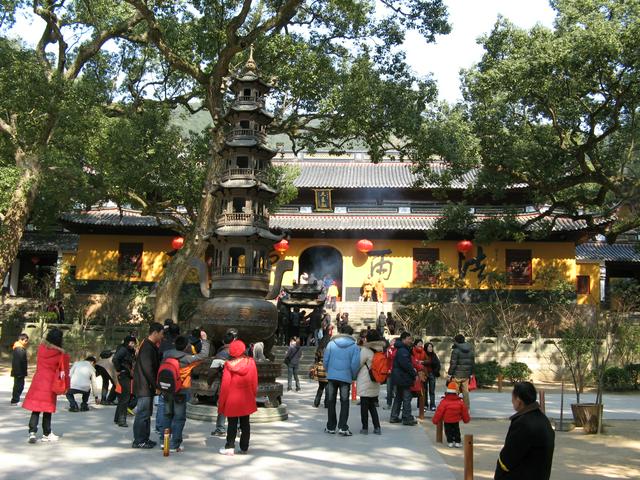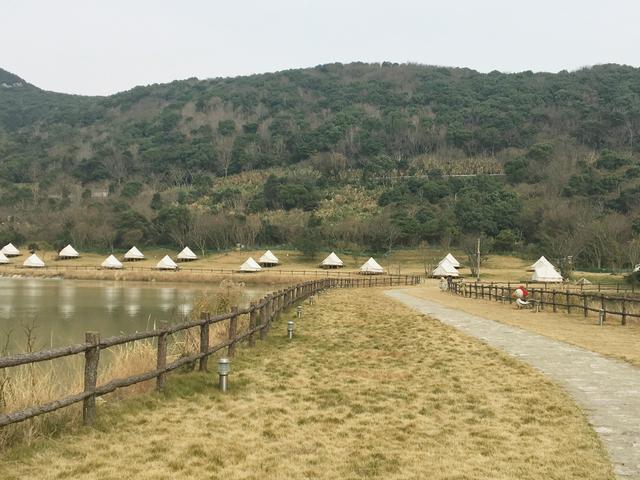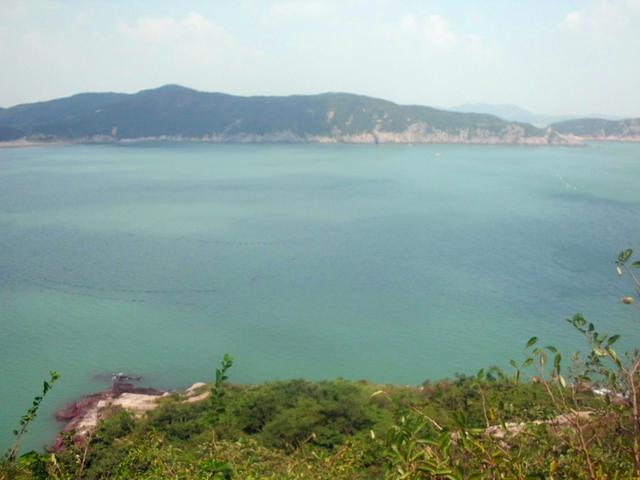Zhoushan, which proudly boasts two national level key scenic areas (Mount Putuo and Shengsi Islands) and two provincial level key scenic areas (Taohua Island and Daishan), is always praised to be the "backyard garden" of Yangtze River Delta. Beside these scenic areas, Zhoushan has an abundance of points of interest, landscape forms and tourism resources, many of which are still under development, due to its rich historic and natural endowment. Conveniently connected to the continental part of the delta, Zhoushan attracted 27.71 million visitors (which is approximately 25 times its population), 310.5 thousand of whom were from abroad, in 2012 alone. Tourism and its related services have risen to be a very important sector of the municipal economy with a total tourism revenue of 26.68 billion yuan, according to the 2012 statistic.
 Mount Putuo National Scenic Area (普陀山国家级重点风景名胜区) consists of two parts, Mount Putuo and Zhujiajian Eastern Coast, although most people would easily ignore the latter part due to its overwhelming fame of Mount Putuo. The scenic area, with a total area of 41.85 square kilometers, is the only place in China where combines the mountain and sea views, and religious culture perfectly.
Mount Putuo National Scenic Area (普陀山国家级重点风景名胜区) consists of two parts, Mount Putuo and Zhujiajian Eastern Coast, although most people would easily ignore the latter part due to its overwhelming fame of Mount Putuo. The scenic area, with a total area of 41.85 square kilometers, is the only place in China where combines the mountain and sea views, and religious culture perfectly.
On a visit in the early 1830s, missionary Karl Gützlaff noted that the island of "Poo-to" boasted two large and 60 small temples, attended by 2,000 monks,
To every person who visits this island, it appears at first like a fairy land, so romantic is everything which meets the eye. Those large inscriptions hewn in solid granite, the many temples which appear in every direction, the highly picturesque scenery itself, with its many-peaked, riven, and detached rocks, and above all a stately mausoleum, the largest which I have ever seen, containing the bones and ashes of thousands of priests, quite bewilder the imagination.
Mount Putuo (普陀山), also named Mount Meicen (梅岑山) and Mount Baihua (白华山), is considered the bodhimanda of Avalokitesvara (Guanyin), a revered Bodhisattva in many parts of East Asia. It is one of the four sacred mountains in Chinese Buddhism, the others being Mount Wutai, Mount Jiuhua, and Mount Emei. However, different from other three sacred mountains which are mountains with heights of more than 1,000 meters, Mount Putuo is actually a small island with a total area of 12.5km2, the highest point of which is Peak Foding (291.3m above the sea level). Mount Putuo features three grand temples (Puji Temple, Fayu Temple, and Huiji Temple), three treasures (Tahoto Pagoda, Yangzhi Guanyin Stele, and Nine-Dragon Caisson), three rocks (Rock Pantuo, Heart Rock, and Rock Ergui Tingfa), three caves (Cave Chaoyang, Cave Chaoyin and Cave Fanyin), 88 nunneries and 128 huts, and twelve scenes. Mount Putuo was praised in various historic records. It is often titled as Bulguksa Among Seas and Skies (海天佛国), or Sacred Ground on the Southern Seas (南海圣境). Mount Putuo is always mentioned in the same breath with the West Lake in Hangzhou, another national scenic area of Zhejiang. West Lake is considered to be the foremost place that combines mountain and lake views, whereas Mount Putuo is deemed as the top place where integrates mountain and sea views (以山而兼湖之胜,则推西湖;以山而兼海之胜,当推普陀).
 Zhujiajian (朱家尖) is the fifth largest island of the archipelago and a newly developed seaside resort with intriguing seascapes, unmarred beaches, dense woods, sheer rock cliffs, hills for hiking, extraordinary seafood and displays of fishermen folk culture. It is home to the Zhoushan International Sand Sculpture Festival, which is held on the Nansha Beach, one of the five consecutive beaches, at the turn of summer and autumn every year. Daqing Mountain is the best location to get the incomparable view of southern Zhoushan Islands and the continental China (Chuanshan Peninsula) on clear days. It is also an ideal place for extreme sports, such as car racing, mountain cycling, gliding, rock climbing and bungee jumping. Baishan Mountain features huge natural rocks of different shapes, Guanyin carving on the cliff, and the Putuo Impression show, directed by Zhang Yimou. Zhujiajian is also the site for Mount Putuo Buddhist Academy. Wushitang (Dark Stone Beach) is the 500-meter beach consisting of numerous dark colored pebbles.
Zhujiajian (朱家尖) is the fifth largest island of the archipelago and a newly developed seaside resort with intriguing seascapes, unmarred beaches, dense woods, sheer rock cliffs, hills for hiking, extraordinary seafood and displays of fishermen folk culture. It is home to the Zhoushan International Sand Sculpture Festival, which is held on the Nansha Beach, one of the five consecutive beaches, at the turn of summer and autumn every year. Daqing Mountain is the best location to get the incomparable view of southern Zhoushan Islands and the continental China (Chuanshan Peninsula) on clear days. It is also an ideal place for extreme sports, such as car racing, mountain cycling, gliding, rock climbing and bungee jumping. Baishan Mountain features huge natural rocks of different shapes, Guanyin carving on the cliff, and the Putuo Impression show, directed by Zhang Yimou. Zhujiajian is also the site for Mount Putuo Buddhist Academy. Wushitang (Dark Stone Beach) is the 500-meter beach consisting of numerous dark colored pebbles.
Shengsi Islands National Scenic Area (嵊泗列岛国家级重点风景名胜区) is the only national level scenic area in China that is established on a group of natural islands. The scenic area, consisting of hundreds of islands outlying the Hangzhou Bay, boasts multiple quality beaches, rocks, and cliffs. Although it is commonly endowed with natural seascape beauty, each island is unique. Jihu and Nanchangtu Twin Beaches, the northernmost sand beaches of Southern China (and the natural beaches closest to Shanghai), make Sijiao Island a popular tourism destination. Shengshan is one of the most important fishing ports on the East China Sea. The eastern coast of Shengshan Island features steep cliffs, an ideal place to view sunrise above the sea. On the north coast is the abandoned fishing village of Houtouwan, now overgrown with vegetation. Gouqi Island is famous for its well-preserved fishing villages and cultures, the largest aquatic farm in China and the Mountain and Sea Wonders (山海奇观) rock that was believed to be left by General Hou Jigao of Ming Dynasty, who defended the southeastern coast against the raids from wokou. Huaniao Island features the Huaniao Lighthouse, initially built in 1870 with the reputation of the first lighthouse of the Far East (远东第一灯塔), that stands on the busiest shipping route in China entering and leaving Shanghai and the Yangtze River. The lighthouse has been on the National Major Historical and Cultural Sites list under protection since 2001.
 Taohua Island is the most botanically diversified island in Zhejiang's coastal area, with nearly 600 species of trees and plants, including oranges, orchids and narcissus – and now peach trees. It is also a popular site for shooting movies and TV series based on Mr. Jin Yong’s novels. Four Chinese TV serials – "The Eagle-Shooting Heroes," "Demi-Gods and Semi-Devils," "The Return of the Condor Heroes" and "Duke of Mount Deer" – were filmed on the island. Starting from 2004, the Jin Yong Martial Arts (Wuxia) Culture Festival is held here every other year around summer. It offers dazzling martial arts performances and competitions, all thrilling for Cha’s fans.
Taohua Island is the most botanically diversified island in Zhejiang's coastal area, with nearly 600 species of trees and plants, including oranges, orchids and narcissus – and now peach trees. It is also a popular site for shooting movies and TV series based on Mr. Jin Yong’s novels. Four Chinese TV serials – "The Eagle-Shooting Heroes," "Demi-Gods and Semi-Devils," "The Return of the Condor Heroes" and "Duke of Mount Deer" – were filmed on the island. Starting from 2004, the Jin Yong Martial Arts (Wuxia) Culture Festival is held here every other year around summer. It offers dazzling martial arts performances and competitions, all thrilling for Cha’s fans.
Daishan (岱山), originally known as Penglai, is believed to be the reached by Xu Fu of Qin Dynasty during his eastward journey to Japan. Mount Moxin, with a height of 257 meters above the sea level, is the highest peak on Daishan Island, from where visitors can get the fantastic view of Gaoting, the county seat, and nearby islands and water channels. Ciyun Temple is the major temple on Mount Moxin and a popular scenic spot. Lulan-qingsha Beach, measuring a length of 3,600 meters and a width of 500 meters, is the single longest beach of Eastern China. It is an ideal place for camping, flying kites, and movie-shooting. The beach is also the location for yearly worship services or matsuris of the ocean for fishing harvest. Dongsha Ancient Town was once the county seat of Daishan, that is famous for hundreds years of commercial and exchange activities associated to traditional fishing industry. Several major buildings and facilities have been well protected. Shuanghe features wonderful large-scale man-made cliffs and precipices which are the result of hundreds years of carving for granite materials for architectural purposes. Daishan has the reputation of being a county of museums. Its collection of museums include themes such as fishing culture, Zhoushan dialect, typhoon, lighthouse, salt production, etc. Besides the above-stated attractions on Daishan Island, other islands are noteworthy as well. For example, Xiushan Island features the only inter-tidal mud theme park in China. Qushan Island features Mount Guanyin, which is also a bodhimanda of Guanyin. Changtu is a traditional fishing port, which is famous for its Wojingtan Hard Cake.
